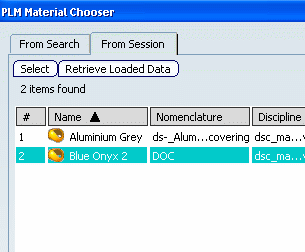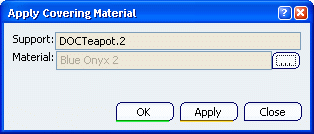Specify the working context by double-clicking a product reference or product instance in the specification tree.
The UI-activated object appears highlighted in blue.
The covering material can be applied to the UI-activated object, to a product instance beneath the
UI-activated object, to a representation instance (3D shape) directly below the UI-activated product reference or product instance, and to elements (3D shapes only) within these representation instances. For more information, see Material Application Supports and Context.
Select a support for the covering material in
the specification tree.
Click Apply Covering Material
 .
.
The
Apply Covering Material dialog box appears.
Click
 to select the material of your choice.
to select the material of your choice.
The PLM Material
Chooser appears. Two tabs are available:
- From Session:
select from materials already loaded in your session.
- From Search:
select from all materials stored in the PLM database.
To display a list of available materials, use one of
the following procedures:
- On the From Session tab, click Retrieve loaded data.
- On the From Search tab, enter a substring of the
desired material's PLM identifier and click Search;
alternatively, you can click Advanced Search
and enter search criteria in the Search Criteria
dialog box.

Select a covering material (e.g.,
Blue Onyx 2) from the list, and click OK.
Covering materials are identified in the PLM Material
Chooser by the
 icon.
icon.
The Apply Covering Material
dialog box is updated accordingly.

Click Apply.
The covering material is applied.
Optional: To
visualize the product to which a covering material is applied,
select the covering material in the specification tree; the
material's support is highlighted both in the specification tree and in the
geometry area:
Up to three covering materials can be applied to a single
support. For more information about priority rules for
multiple covering materials, see Material Application Supports and Context.